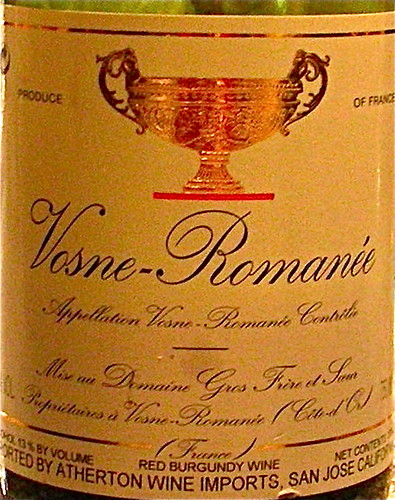Champagne is a sparkling wine from the Champagne region produced with a carbonation method called méthode champenoise or méthode traditionnelle: after primary fermentation and bottling, a second fermentation is induced by adding yeast and sugar in the bottle. The bottle is then sealed and the wine continues to age for a minimum of 1.5 years to add complex toasty and yeasty flavors. When the aging process is complete, the dead yeast cells are removed and the bottle is corked.
Champagne is typically a blend of the three official varietals of Champagne: Pinot Noir, Pinot Meunier and Chardonnay. They are generally assembled from different vineyards and harvests. Still red wine from Champagne can be added to produce a Champagne rosé. Blanc de Noirs is a white sparkling wine produced entirely from black grapes. Conversely, Blanc de Blancs is made only from Chardonnay grapes and mostly produced in the Côte des Blancs.
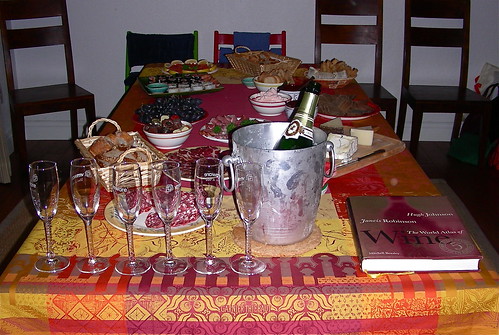
The wines we tasted:
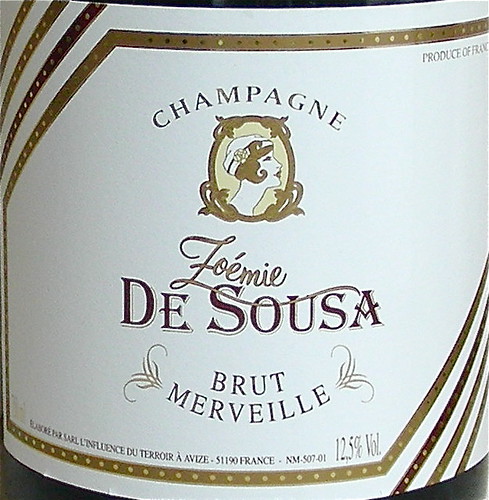 • Champagne Zoémie de Sousa Brut Cuvée Merveille. Champagne de Sousa is a 5.5 hectare property located in the heart of the prestigious Côte des Blancs with some vineyards classified as Grands Crus. Planting is 40% Pinot Noir, 10% Pinot Meunier, and 50% Chardonnay. Erick de Sousa who has been managing the Domaine since 1986, is now part of the absolute elite of Champagne growers-producers and his production is now been sought out by many gourmet restaurants. My notes: aromatic nose, fruity, assertive bubbles, good acidity. Great for the aperitif.
• Champagne Zoémie de Sousa Brut Cuvée Merveille. Champagne de Sousa is a 5.5 hectare property located in the heart of the prestigious Côte des Blancs with some vineyards classified as Grands Crus. Planting is 40% Pinot Noir, 10% Pinot Meunier, and 50% Chardonnay. Erick de Sousa who has been managing the Domaine since 1986, is now part of the absolute elite of Champagne growers-producers and his production is now been sought out by many gourmet restaurants. My notes: aromatic nose, fruity, assertive bubbles, good acidity. Great for the aperitif.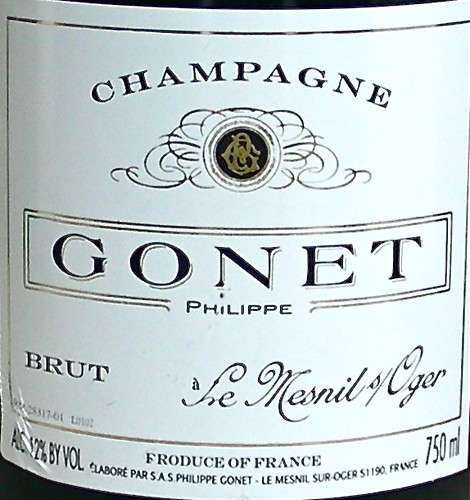 • Champagne Philippe Gonet Brut Blanc de Blancs: Champagne Philippe Gonet is a family champagne house with 19 hectares of vineyards in the heart of the Cotes de Blancs that are farmed using sustainable agricultural methods. This cuvée is 100% Chardonnay from the 2004 and 2003 harvests. Half the blend is made of fruits sourced from Grand Cru vineyards. My notes: light color, sour apple aromas on the nose, fine bubbles, crisp acidity. I found this one more mono-dimensional than the other Champagnes.
• Champagne Philippe Gonet Brut Blanc de Blancs: Champagne Philippe Gonet is a family champagne house with 19 hectares of vineyards in the heart of the Cotes de Blancs that are farmed using sustainable agricultural methods. This cuvée is 100% Chardonnay from the 2004 and 2003 harvests. Half the blend is made of fruits sourced from Grand Cru vineyards. My notes: light color, sour apple aromas on the nose, fine bubbles, crisp acidity. I found this one more mono-dimensional than the other Champagnes.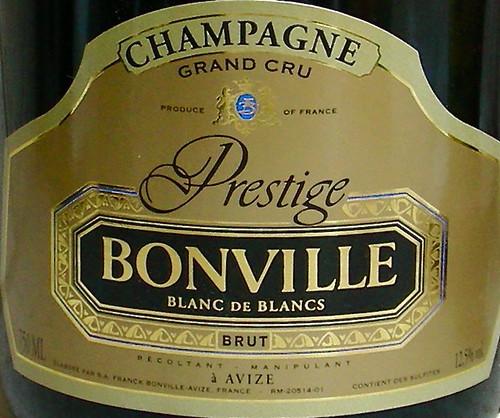 • Champagne Franck Bonville Brut Prestige Blanc de Blancs: Champagne Franck Bonville is a family enterprise making Champagne from fruit grown in the Grand Cru villages of Avize and Oger. This wine is a blend of the 2002, 2000 and 1998 vintages, all sourced from old vines from the estate Grand Cru vineyards. My notes: lighltly colored, aromatic nose, rich complexity on the palate, mineral finish. This crowd pleaser was indeed the winner of the evening!
• Champagne Franck Bonville Brut Prestige Blanc de Blancs: Champagne Franck Bonville is a family enterprise making Champagne from fruit grown in the Grand Cru villages of Avize and Oger. This wine is a blend of the 2002, 2000 and 1998 vintages, all sourced from old vines from the estate Grand Cru vineyards. My notes: lighltly colored, aromatic nose, rich complexity on the palate, mineral finish. This crowd pleaser was indeed the winner of the evening!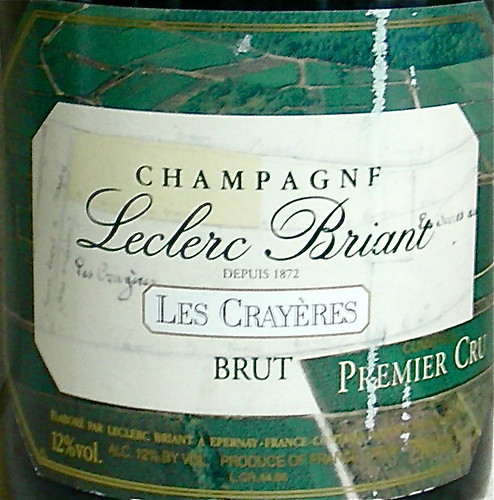 • Champagne Leclerc Briant Les Crayères: Champagne Leclerc Briant cultivates 30 hectares of vineyards between the Montagne de Reims and the Marne valley, using biodynamic farming methods. The maturing cellars are made of over 1 km of galleries dug in solid chalk 30 metres underground. This blend is 38% Pinot Noir, 37% Meunier and 25% Chardonnay sourced from a single vineyard called Les Crayères (The chalk mine), an exceptional terroir: vines have deep roots in that very shallow soil followed by a deep subsoil layer of chalk. My notes: our first bottle was unfortunately flat, the second one was much better. Light golden color, apple cider aromas on the nose, a toasty and winey palate, dominated by Pinot flavors.
• Champagne Leclerc Briant Les Crayères: Champagne Leclerc Briant cultivates 30 hectares of vineyards between the Montagne de Reims and the Marne valley, using biodynamic farming methods. The maturing cellars are made of over 1 km of galleries dug in solid chalk 30 metres underground. This blend is 38% Pinot Noir, 37% Meunier and 25% Chardonnay sourced from a single vineyard called Les Crayères (The chalk mine), an exceptional terroir: vines have deep roots in that very shallow soil followed by a deep subsoil layer of chalk. My notes: our first bottle was unfortunately flat, the second one was much better. Light golden color, apple cider aromas on the nose, a toasty and winey palate, dominated by Pinot flavors.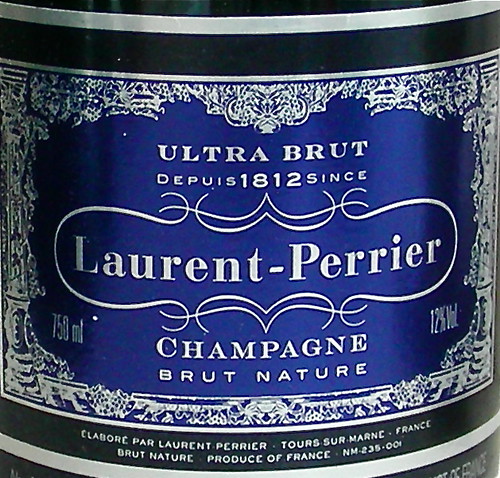 • Champagne Laurent-Perrier Ultra Brut: when no sugar is added during the second fermentation in the bottle, the Champagne is labeled Ultra Brut. This cuvée is produced by Champagne Laurent-Perrier, the largest family-owned Champagne House. The blend is 55% Chardonnay, 45% Pinot Noir sourced from Grand cru vineyards, and exclusively coming from very ripe harvests, in this case, 1995. A rigorous selection ensures that only grapes with both high sugar levels and low acidity are used. My notes: forward fruits on the nose with mineral notes, very distintive palate with a lot of depth, long finish. One of my favorite wines of the evening.
• Champagne Laurent-Perrier Ultra Brut: when no sugar is added during the second fermentation in the bottle, the Champagne is labeled Ultra Brut. This cuvée is produced by Champagne Laurent-Perrier, the largest family-owned Champagne House. The blend is 55% Chardonnay, 45% Pinot Noir sourced from Grand cru vineyards, and exclusively coming from very ripe harvests, in this case, 1995. A rigorous selection ensures that only grapes with both high sugar levels and low acidity are used. My notes: forward fruits on the nose with mineral notes, very distintive palate with a lot of depth, long finish. One of my favorite wines of the evening.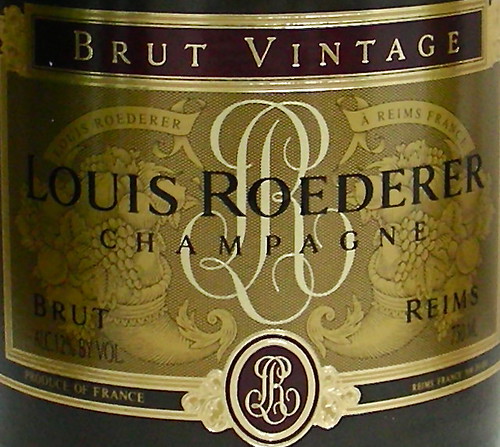 • 2000 Champagne Louis Roederer Vintage Brut: when the harvest is exceptional, a Millesimé or Vintage wine is declared. A Vintage cuvée is made with fruits from a single harvest and has to mature for at least 3 years in bottle. This wine is produced by Champagne Louis Roederer, one of the largest remaining independent Champagne Houses, owned by the same family since its foundation in 1776. It is a blend of 67% Pinot Noir and 33% Chardonnay sourced almost exclusively from the Roederer estate Grand and Premier Cru vineyards. My notes: expressive fruity nose, good acidity, clean flavors on the finish, but I have to say, I was slightly disappointed by this wine.
• 2000 Champagne Louis Roederer Vintage Brut: when the harvest is exceptional, a Millesimé or Vintage wine is declared. A Vintage cuvée is made with fruits from a single harvest and has to mature for at least 3 years in bottle. This wine is produced by Champagne Louis Roederer, one of the largest remaining independent Champagne Houses, owned by the same family since its foundation in 1776. It is a blend of 67% Pinot Noir and 33% Chardonnay sourced almost exclusively from the Roederer estate Grand and Premier Cru vineyards. My notes: expressive fruity nose, good acidity, clean flavors on the finish, but I have to say, I was slightly disappointed by this wine.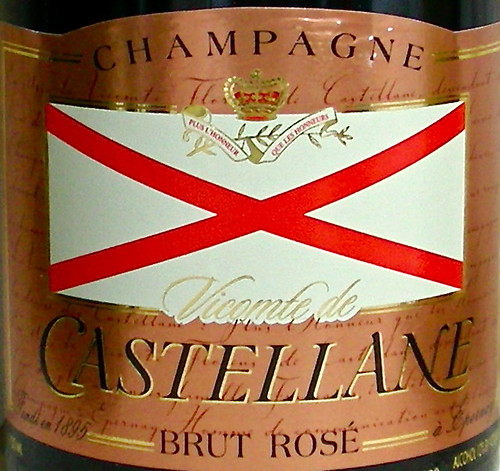 • Champagne de Castellane Brut Rosé: Champagne de Castellane was founded in 1895 by Vicomte Florens De Castellane, member of one of the oldest noble families in France. This wine is a blend of three grapes dominated by Pinot Noir, 15% of which being still red wine. My notes: light salmon color, pleasant fruity nose, fresh and delicate palate, slightly bitter finish.
• Champagne de Castellane Brut Rosé: Champagne de Castellane was founded in 1895 by Vicomte Florens De Castellane, member of one of the oldest noble families in France. This wine is a blend of three grapes dominated by Pinot Noir, 15% of which being still red wine. My notes: light salmon color, pleasant fruity nose, fresh and delicate palate, slightly bitter finish.For our next tasting event, we'll be pairing cheese and wine. Soft, hard, blue, cow, goat, sheep cheese: which wines will work the best with all these cheeses? Stay tuned!
Previous wine club tastings:
• Tasting the wines of South America
• Tasting Summer Wines from around the Mediterranean Sea
• Guess the wine tasting
Technorati tags: wine food & drink
